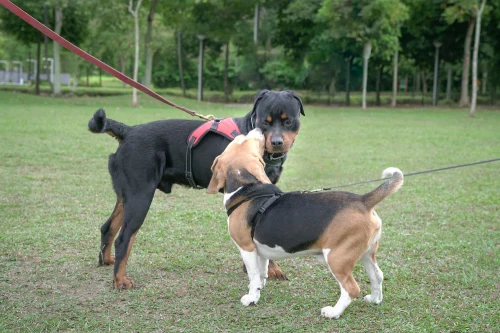Key Takeaways
On-leash greetings can lead to injury, conflict, or liability. Even friendly dogs can have miscommunications or get tangled in leashes.
Saying “no” to interactions isn’t rude—it’s responsible. Your job is to protect your dog and others during walks.
Use polite language and body cues (like crossing the street or creating space) to signal your boundaries clearly.
Helpful gear can reinforce your message. Vests or harnesses with phrases like “Do Not Pet” can deter unwanted approaches.
Professional dog walkers must carry liability insurance and assess risks before taking on clients.
Safe walks are confident walks. Boundaries help ensure positive, predictable experiences for everyone involved.
At Burnell Pets, we love a good walk; fresh air, tails wagging, and paws hitting the pavement (or dirt and grass preferably). But there’s one rule we always follow (and recommend to every pet owner or professional dog walker): Do not allow your dog to meet other dogs or people while out on walks.
May is Responsible Animal Guardian Month, and this article is here to help highlight one important way to be a responsible animal guardian: by learning how to keep dogs, and the people around them, safe during walks.
We get it. This might sound overly cautious or even unfriendly. But when it comes to dog walking, safety and liability come first. Whether you’re walking your own pet or a client’s dog as a professional, this rule isn’t about being rude. It’s about being responsible.
Why You Should Avoid On-Leash Greetings
1. Liability is Real (and Costly)
In a webinar hosted by the Business Insurers of the Carolinas, a tragic examples an on-leash greetings were shared including the following example:
A dog walker allowed a client’s dog to interact with another dog. As they played, the leashes became tangled around a nearby person who fell, suffered a brain injury, and later died. The resulting lawsuit? $454,284.
When you’re walking a dog, your job is to protect the world from the pets in your care. That means thinking two steps ahead, and sometimes that means saying “no” to what seems like a harmless hello.
2. Miscommunication Between Dogs is Common on Leash
Dogs rely heavily on body language to communicate. When they’re on leash, their ability to use that language is restricted, especially if the owner tightens the leash out of nervousness or caution. This tension can signal stress or aggression to another dog, even if that’s not what your dog intends to say. Friendly on-leash greetings can quickly become a stressful or even dangerous ones. One of the first rules we learned as Certified Dog Bite Prevention Educators is: Don’t greet on leash.
3. Leashes Can Create Hazards
Even well-meaning, well-mannered dogs can pose a risk when their leashes get tangled. Not just around each other, but around people. Tripping, rope burns, or falls caused by leash entanglement are real, preventable injuries that can lead to expensive claims and heartbreaking consequences.
4. You Never Know What Will Set a Dog Off
Even the calmest dog can react unpredictably to a scent, movement, or person. A dog might be uncomfortable with hats, children, skateboards, other dogs for example. Don’t take the risk by allowing others to pet your dog, especially children.
The answer is always “no.”
Tips for Saying “No” Without Feeling Mean
It’s not always easy to turn someone down, especially when they’re smiling and walking toward your adorable pup. But polite boundaries keep everyone safe. Here are a few helpful strategies and phrases you can use:
Use Clear, Friendly Language
Keep your tone calm, your expression friendly, and your message consistent:
“He’s in training, so we’re avoiding interactions right now.”
“She’s a little nervous, so we don’t do meet-and-greets on walks.”
“Thanks for asking, but we’re working on focus today.”
“He’s not great with other dogs/people, so it’s best we keep our distance.”
“We’re keeping space to avoid tangles. It’s happened before!”
Use Body Language and Space
You can also send a clear, polite message with your actions:
If you see another dog approaching, calmly cross the street or change direction. This signals that you’re not looking to engage without needing to say a word.
Move slightly off the path or create distance, using your own body as a gentle barrier.
Pair this with a friendly wave or a quick “hello” as you pass. This helps avoid awkwardness while still maintaining your boundaries.
Use Visible Messaging
You can also equip your dog with a vest or harness that displays a clear message such as:
“Do Not Pet”
“Ask Before Approaching”
“Do Not Approach”
These visual cues help set expectations for strangers in advance and can make it easier to enforce your boundaries without having to say a word.
Offer a Controlled Alternative (If Appropriate)
If the other person seems especially eager for their dog to say hi, and if you feel it might be a good match, you can offer:
“He doesn’t do greetings on walks, but maybe we can set up a playdate in a fenced yard sometime?”
This shows you’re not unfriendly; you’re just intentional about how and when your dog socializes.
Remember: “No” Is Enough
You’re allowed to say no. Whether you’re the dog owner or a professional walker, your first responsibility is to your dog’s safety and the safety of others.
If someone doesn’t take your polite “no” seriously, that’s on them, not you.
If You’re a Professional Dog Walker: Insurance Is a Must

Walking a dog isn’t just a casual stroll; it’s a business responsibility. As a professional, you should always carry liability insurance. Even if you’re cautious, things can go wrong. And if they do, you want to be protected.
Before accepting a new dog client, assess their behavior and potential risk. Are they reactive? Do they lunge at strangers? Can they be safely walked near other dogs? These are not just behavior concerns; they are liability concerns.
Also, always stay alert:
Look ahead, behind, and to the sides during your walk.
Avoid areas or situations that might lead to unexpected interactions.
Never let dogs meet on leash, even if both owners say it’s okay.
Walks Should Be Safe and Enjoyable For Everyone
Boundaries on a walk aren’t about isolation; they’re about protection, safety, and responsible pet care. When you say “no” to on-leash greetings, you’re not being unkind. You’re being a confident, thoughtful advocate for your dog’s wellbeing.
Let’s change the culture around dog walking: polite boundaries are smart, not mean.
Need help with leash manners, body language, or choosing safe gear for your walks? Burnell Pets offers consultations to help dog owners walk with confidence. Contact us to learn more.
